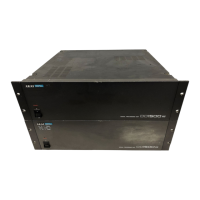UTILITIES - RS422 - AUTO CONFORM - 18
Version 2.00 - March, 1996 Page 169
You will appreciate that there are many variations on the complex process of film making.
The following description is intended as a general overview and is unlikely to represent
exactly any actual production!
Scenes are shot in the studio or on location. Pictures are recorded onto either film or video
depending on the creative requirements of the director. Sound is usually recorded onto
Nagra tape machines, but may also be recorded onto time-coded DAT or even onto the
audio tracks of the video itself. Some productions may record multiple mono and/or stereo
sounds onto several recorders during the picture shoot.
The time code striped onto the audio recorders is known as ‘time of day’, referenced to a
quartz crystal locked clock. Film, of course, has no time code recorded onto it at the shoot,
and time information must be obtained later from the clapperboard and camera operator's
log. Video cameras do stripe the picture tape with time code and this is also generated
from a separate quartz crystal-locked clock. Usually the camera and sound operators will
synchronise their clocks at the beginning of a day's work, but sometimes, being human,
they might forget. So it is possible that even on a video shoot there might be several
seconds of difference between audio and picture time code.
Once the shooting is over, any film shot will be sent for developing and telecine transfer to
video. Audio will often undergo a process called "syncing rushes", where the audio is
recorded into a digital audio workstation, synchronised to the video picture and then
replayed out with time code to a time coded DAT tape to produce "sync DATs".
The picture rushes are edited together either in a conventional video editing suite or on a
non-linear video editing system to produce a master tape. In some cases some
preliminary sound editing may also be done. Particularly in the case of a non-linear video
edit, this sound editing might be quite extensive and the director may require some of the
sound chosen at this stage to be used in the final production. Hence an 8 track digital
tape of the audio from the non-linear editing system may also be added to the growing
pile of video tapes and sync DATs.
When the picture edit is complete, the editing system will output an Edit Decision List
(EDL) onto a 3.5" floppy disk in one of a number of standard formats (CMX, Sony, Grass
Valley, etc.). This EDL contains all of the information from the editing session about which
parts of the source tapes were chosen. A typical entry in this EDL may look something like
this:
01:12:23:05 01:13:23:05 00:15:10:00 00:16:10:00A12V012345012
No Reel Edit IN OUT
SOURCE DESTINATION
IN OUT
The fields shown across the top of the EDL are as follows:
The NO field shows the edit number - in this case, this is edit 012.
The REEL field shows the number of the source reel (i.e. tape) which the material
comes from. Each reel has its own unique number. In this case the reel number is
012345.
The EDIT field shows the type of edit being made (i.e. video, audio or
video+audio). In this case the edit is on audio tracks 1 and 2 and video (A12V).
The SOURCE IN/OUT fields show the start and end times for material as it exists
on the source reel.
The DESTINATION IN/OUT fields show the start and end times for the material as
it will be placed on the master tape.

